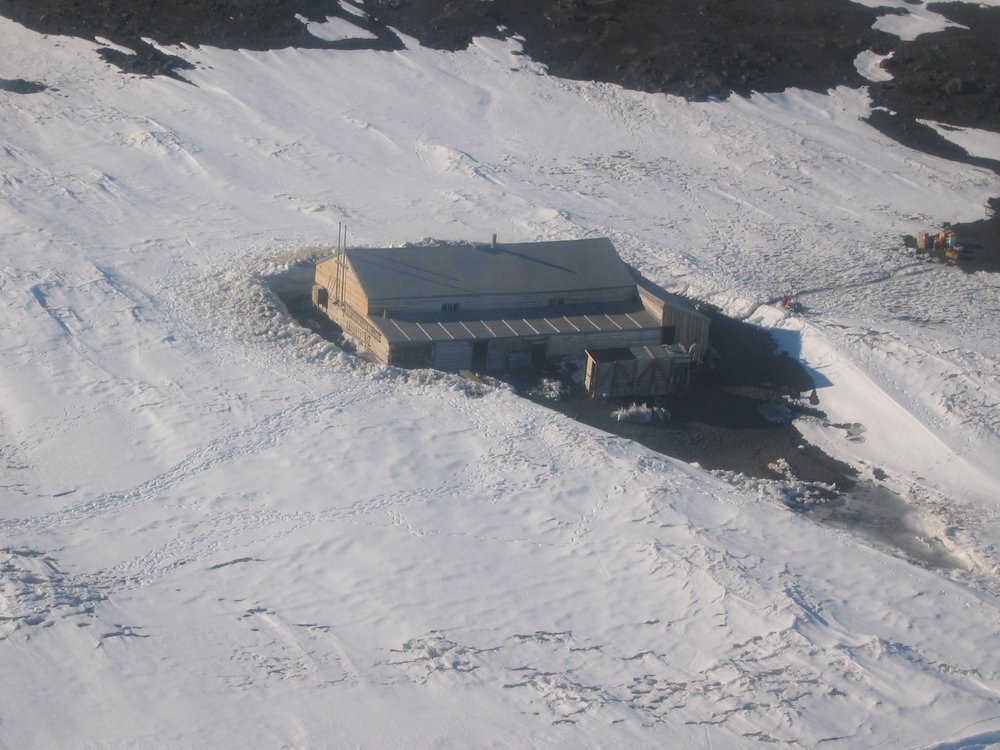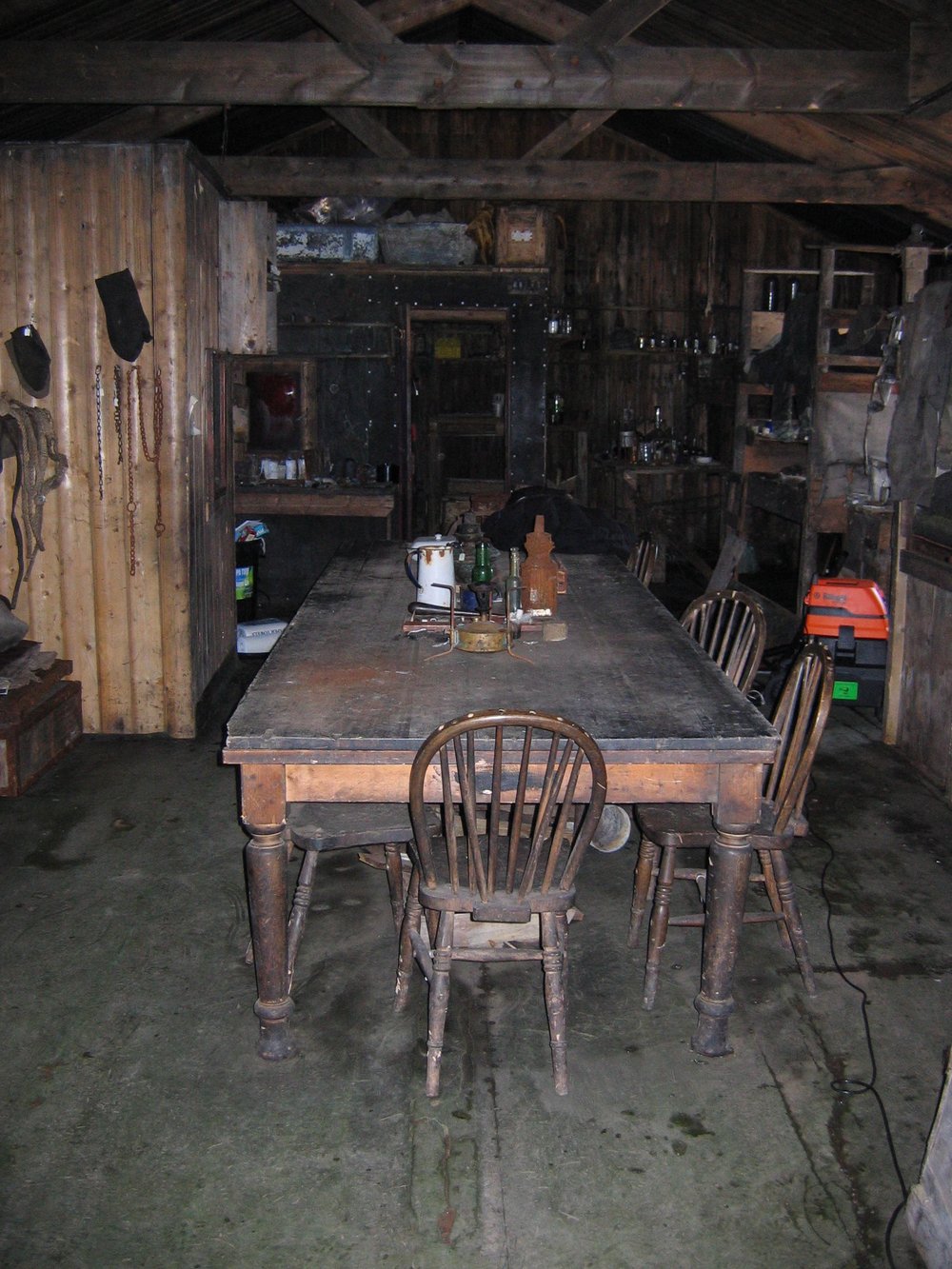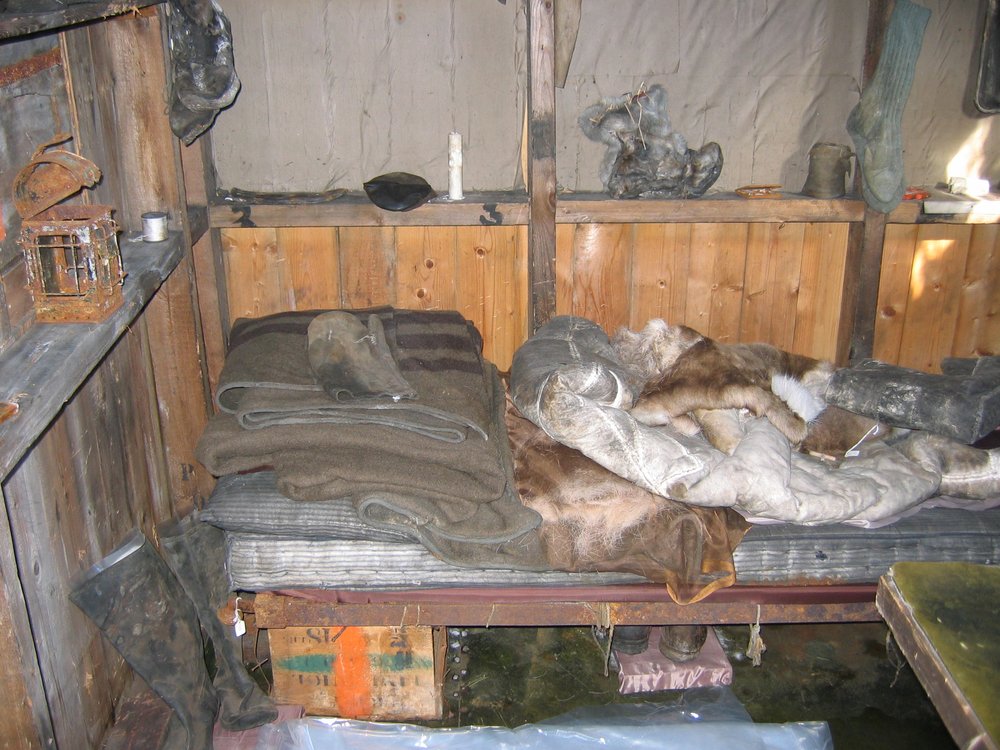Antarctic News

At age 15, Jordan Romero has just climbed Mount Vinson, making him the youngest person to summit the highest peaks on 7 continents. At 10 he completed three of these summits.
Then there is the usual disaster: a Russian fishing ship is sinking after tearing a hole in its hull.

At age 15, Jordan Romero has just climbed Mount Vinson, making him the youngest person to summit the highest peaks on 7 continents. At 10 he completed three of these summits.
Then there is the usual disaster: a Russian fishing ship is sinking after tearing a hole in its hull.

But the piece of news that has most moved me (being, as I said, a Scott woman) is about Scott’s grandson, who is a carpenter, traveling to Antarctica to help work on the hut his grandfather lived during the Terra Nova expedition (1910-13). It is the New Zealand Heritage Trust who is in charge of maintaining this hut, and Scott will be joining others to keep it in shape. In using his carpentry skills, he will be keeping his grandfather’s memory alive in a unique manner.
I was lucky enough to visit this hut during my six weeks on the ice. The day I flew in by helicopter, the Kiwis (as they called themselves) where there fixing up the hut. I wandered through the small hut (where someone was doing a good vacuuming) looking at the long wooden table where the men ate, the small closet where photographer Herbert Ponting processed his photographs, and the stables where they kept their ponies. There in the stable I saw the mini snowshoes that the horses wore to try and make them more mobile on the ice. A box of cracked penguin eggs stacked in a wooden box made me think that penguin eggs must make for good eating.

I found looking at Scott’s toothbrush, still in a glass on a shelf, his bed with its reindeer sleeping bag, finneskos (reindeer boots) and mittens quite moving. I could feel the presence of these men who sweated, and dreamed together on this far continent. I can imagine that to see where you grandfather spent his last months before heading south for the pole (which he reached 34 days after Amundsen) would be incredibly special. I wish him safe journey.
Harris
 Harris's Sparrow taken by Peter Schoenberger“Harris is still there,” Peter tells me.
Harris's Sparrow taken by Peter Schoenberger“Harris is still there,” Peter tells me.
This has been his report every few days, since the 26th of November. Harris is the Harris’s sparrow he found on November 26 in Berks County Pennsylvania while we were visiting his sister in Kempton. Almost a full month later, and Harris is still there.
“And people are still going out to look for it?” I ask, a bit surprised at the determination of birders.
“It’s an important bird,” Peter says, as if stating the obvious.
 Harris's Sparrow taken by Peter Schoenberger“Harris is still there,” Peter tells me.
Harris's Sparrow taken by Peter Schoenberger“Harris is still there,” Peter tells me.
This has been his report every few days, since the 26th of November. Harris is the Harris’s sparrow he found on November 26 in Berks County Pennsylvania while we were visiting his sister in Kempton. Almost a full month later, and Harris is still there.
“And people are still going out to look for it?” I ask, a bit surprised at the determination of birders.
“It’s an important bird,” Peter says, as if stating the obvious.
 Whimbrel, photographer unknownThe Harris’s sparrow is named for Edward Harris, who also gives his name to the Harris’s hawk, the dark western species of the Hairy Woodpecker (Dryobates villosus harrisi), and to the Yuma Antelope Squirrel. Born in Moorestown, New Jersey in 1799, he was the heir to his father’s fortune, made in hosiery. Early in life he befriended Audubon by buying his drawings--Audubon “would have kissed him, but that is not the custom in this icy city [Philadelphia].” Later, he slipped Audubon a hundred dollar bill, explaining, “men like you ought not to want for money.” He accompanied Audubon on his 1843 Missouri River expedition. There, he shot a small bird, or a large sparrow (depending on how you see it) with a black crown and throat, ash colored cheeks and a pink bill. Audubon named it Fringilla Harrisii, though the bird had already been named by Thomas Nuttall in 1834. Where the bird was found was on the eastern edge of their wintering range; it’s a bird that breeds in Canada’s boreal forest. So the bird we saw was far east of where it belongs. Far east.
Whimbrel, photographer unknownThe Harris’s sparrow is named for Edward Harris, who also gives his name to the Harris’s hawk, the dark western species of the Hairy Woodpecker (Dryobates villosus harrisi), and to the Yuma Antelope Squirrel. Born in Moorestown, New Jersey in 1799, he was the heir to his father’s fortune, made in hosiery. Early in life he befriended Audubon by buying his drawings--Audubon “would have kissed him, but that is not the custom in this icy city [Philadelphia].” Later, he slipped Audubon a hundred dollar bill, explaining, “men like you ought not to want for money.” He accompanied Audubon on his 1843 Missouri River expedition. There, he shot a small bird, or a large sparrow (depending on how you see it) with a black crown and throat, ash colored cheeks and a pink bill. Audubon named it Fringilla Harrisii, though the bird had already been named by Thomas Nuttall in 1834. Where the bird was found was on the eastern edge of their wintering range; it’s a bird that breeds in Canada’s boreal forest. So the bird we saw was far east of where it belongs. Far east.
When Peter found the Harris’s sparrow we were walking a nondescript small back road, scanning wide farm fields hoping to see snow buntings. Peter noticed sparrows in the dense brush and after pishing, a few birds sat up. In an instant he cried out: “Harris’s!”
It’s not a bird that I had even heard of. Peter had seen one other Harris’s sparrow in his life. That he knew right away what it was stunned me.
“A what?” I asked. He was too focused on making sure he was right in his identification that he didn’t answer. I stood and looked around at the vast fields, at the simple patchwork of small farms. I knew I should be excited. This wasn’t just an unusual bird, it was a rare bird.
“The rarest bird I’ve found,” Peter explained later.
 Red Phalarope, photo by Peter SchoenbergerI cataloged the rare birds Peter had found just this past year: a LeConte’s sparrow (in Dutchess County, NY), a Henslow’s Sparrow (near Ames, NY), (notice the emphasis on sparrows), a Whimbrel (on the Hudson River south of Saugerties) and a Red Phalarope (in Dutchess County, NY). In each instant, I got right away that they were special birds. I understood their specialness, but also, I could feel it in my bones. But the Harris’s sparrow was not making my adrenalin flow.
Red Phalarope, photo by Peter SchoenbergerI cataloged the rare birds Peter had found just this past year: a LeConte’s sparrow (in Dutchess County, NY), a Henslow’s Sparrow (near Ames, NY), (notice the emphasis on sparrows), a Whimbrel (on the Hudson River south of Saugerties) and a Red Phalarope (in Dutchess County, NY). In each instant, I got right away that they were special birds. I understood their specialness, but also, I could feel it in my bones. But the Harris’s sparrow was not making my adrenalin flow.
Perhaps it was because the day before we had seen a snowy owl, a special bird that is also big and white and adorable to watch? I can’t say. Some birds move me, others do not.
But what excited and intrigued us both was what were the chances that we would drive this back road? Stop at this spot and notice the sparrows? How many other rare birds lurk in the nondescript brushy rows in Pennsylvania? The mind starts to bend with the possibilities.
When Peter found the Red Phalarope on a vast vegetable farm in Red Hook, NY, he posted it to the bird lists. People swarmed from near and far to see it and in that mass of people were some good birders. Who found other good birds while they were there, like a Nelson’s Sparrow and a Lapland Longspur. That’s when Peter found the LeConte’s Sparrow. This phenomenon is known as the Patagonia picnic table effect. In Patagonia Arizona one rare bird was found at a picnic rest stop. Birders congregated, finding even more good birds. This birding phenomenon happens frequently, or frequently enough to have been given a name (posted on Wikipedia, no less).
But no other special birds have been found near the Harris’s (one person reported pishing out a big orange cat). It’s just Harris, one special sparrow on an unassuming back road in eastern Pennsylvania.
Quotes take from From Audubon to Xanthus: The Lives of Those Commemorated in North American Bird Names by Barbara and Richard Mearns.
Christmas Bird Count 2011

This was my second Christmas Bird Count and the memory of my first count was vivid for me. Last year had been exhausting and exhilarating and I had been looking forward to this day more than to Christmas itself. Like for all good holidays, I’d spent the day before cooking so that we’d have good chicken soup to eat in the field. We’d gone to bed early and I rose at 3 am, full of hope, just as I had as a child when I still believed in Santa. Now, I believed in owls. To find an owl, you have to believe in owls.

This was my second Christmas Bird Count and the memory of my first count was vivid for me. Last year had been exhausting and exhilarating and I had been looking forward to this day more than to Christmas itself. Like for all good holidays, I’d spent the day before cooking so that we’d have good chicken soup to eat in the field. We’d gone to bed early and I rose at 3 am, full of hope, just as I had as a child when I still believed in Santa. Now, I believed in owls. To find an owl, you have to believe in owls.
 Yellow-bellied sapsucker taken in 2010 by Peter SchoenbergerBelief took us far. We started with the eerie call of a screech owl in the low fields of our count sector; a quick trip up toward dense pine trees brought a saw-whet owl that came in and soared over our heads; a barred owl hooted from the dark, and a great horned owl did the same.
Yellow-bellied sapsucker taken in 2010 by Peter SchoenbergerBelief took us far. We started with the eerie call of a screech owl in the low fields of our count sector; a quick trip up toward dense pine trees brought a saw-whet owl that came in and soared over our heads; a barred owl hooted from the dark, and a great horned owl did the same.
Then the sun rose, a marvelous display as we roamed the fields looking for snow buntings (with no luck). And our daylight hours began. It is hard to top hearing four owls in such a short period of time. But six hooded mergansers with their striking white hoods that puddled about in an open pond cheered us on as we rounded up the chickadees, tufted titmouse, and cardinals to our list.
Despite the owls, by eleven our spirits were flagging. Birders are addicts, looking for the next bird high. Our last one had been at 5 in the morning, six hours ago. I was hungry. My body already felt tight from getting in and out of the car, walking a few miles, driving many more.
As we cruised through a dense woods on a one and a half lane road, Laura said, calmly, from the back seat: a big bird. Laura’s keen eye had already brought us many red-tailed hawks at the edges of fields. Peter braked, backed up. And the big bird was sitting in a tree, staring back with its barred owl eyes. That gave us the adrenalin we needed to get us to three, when again my spirits flagged.
“Big bird,” Peter said pointing to a dot, impossibly high in a blue sky. An eagle. “Let me be sure it isn’t a golden eagle,” he said. A scoped look made us all conclude it was a golden eagle and we had another rush of excitement (analyzing the photos later, however, told another story—it was a bald eagle).
We continued our counting, little marks next to the crows, blue jays, a flicker, a yellow-bellied sapsucker, many downy and hairy woodpeckers. A reliable kestrel waited until 4:30 to make an appearance. And then after driving 100 miles and walking 5, our day was over. We gathered for food and drink with others from our circle, also red-faced from the wind and sun of the day, also tired but happy. There were reports of some good birds, like the stocky white-winged scoters from the Ashokan reservoir. There was the discussion about the enormous flock of grackles that moved from one sector to the other: how should they be counted. The total tally of birds was somewhere around 10,000. That, above all, cheered me. When I think of all the animals I see crushed on our roads, or read of birds that collide with buildings and into windows I worry about declining populations of all creatures in the wild (except starlings and house sparrows, perhaps). As I ate the food prepared by friends, and listened to the chatter about birds, all I thought was these birds are the real gift of this season.
Last of the Season?

I drove to the Tivoli landing at 3:30, late for a November paddle. The dock was underwater at high tide. “Four and a half feet of tide,” a motorcyclist loitering by the water’s edge said. He then asked if I had any matches. I shoved onto the water as I smelled the distinct sweet smell of pot float out onto the water with me.

I drove to the Tivoli landing at 3:30, late for a November paddle. The dock was underwater at high tide. “Four and a half feet of tide,” a motorcyclist loitering by the water’s edge said. He then asked if I had any matches. I shoved onto the water as I smelled the distinct sweet smell of pot float out onto the water with me.

The tide was so high I could barely slip under the railroad bridge and into the North Tivoli Bay. But once I squeeze through an even greater calm took hold. I realized I would be paddling into dusk and hoped for an owl—why not?—to come out and join me.
I meandered past the dried cattails, the reeds now dusty beige. A swamp sparrow hopped up to look at me. I took my time, savoring the texture of the water, the clear coolish air, the quiet. Then I heard a shuffling along the shoreline, in the leaves. I imagined a beaver there, or some other animal coming to drink. To my surprise, there shuffled a pair of wood ducks. I had never been so near to these beautiful, vivid ducks, with their magnificent colors—the glossy green of the male’s head and the distinct white circle around the female’s eye. I slid away, whispering to them: don’t move, stay right there. Still, they took off, a rush of wings. They took to the air and looped south. I paddled on, unsettled that I had flushed these birds. And then: a shot rang through the air. I stopped paddling; my shoulders hunched. My wood ducks had been shot. I looked to the sky to see if one tumbled to ground. One duck lagged behind the other—perhaps wounded?—but they were both winging north. I watched until they disappeared on the horizon. I would never know what happened to those ducks. But my first thought was: I killed these ducks. If I had not flushed them they would be safe on shore in the north bay. And in that moment I vowed not to paddle in the bays during duck season again. This is not what I had in mind for my final paddle of the season.

“Do you fish here often?” I asked.
“I do,” he said without looking toward me.
“Do you ever hear owls?” I asked.
“Not owls,” he said. “I saw one once, but it was hit by a train.”
No, this was not what I was looking for on my final paddle of the season. I coasted out of the bay and back onto the river, then chugged my way north. As I pulled my boat out at the dock—now above the tide line—darkness set in. And I thought: this can’t be my final paddle of the season. Though it is often the complexity of the river that intrigues me—tug boats sharing the water with kayaks, industry next to snapping turtles—on this final paddle I wanted only the good. So I will go out one more time looking for an outing that leaves a cleaner taste, a happier memory.
